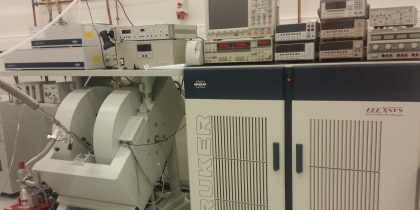dr hab.
Aneta Drabińska
prof. UW
Faculty of Physics
University of Warsaw
Microwave Spectroscopy Laboratory

Electron Spin Resonance (ESR)
ESR spectroscopy is used in various branches of science as a sensitive tool allowing for detection of unpaired electrons in in a given material. It can be applied not only for detection of free radicals, transition metals or rare earth metals, but also defects in materials or conduction electrons in metals and semiconductors.
In general, ESR spectroscopy entails the measurement of changes in the microwave-cavity quality factor (Q) as a function of magnetic field. The quality factor of the resonator can vary for different reasons. In case of a classical ESR measurement, changes in the cavity Q-factor due to energy absorption (A) by spins are recorded. The absorption of microwave radiation leads to magnetization change and in a typical ESR spectrometer the signal is proportional to dA/dB.
The Q-factor of the cavity can also change due to variation of the sample resistivity. In this case, the signal recorded by the ESR spectrometer is proportional to dσ/dB, where σ is the sample conductance. Therefore, with the use of the ESR spectrometer it is also possible to measure contactless magnetoconductance, including Shubnikov-de Haas oscillations or weak (anti-)localization features.

Electroreflectance (ER) and Photoreflectance (PR)
The basic phenomena that stands behind this technique is to modulate electric field present in the structure and to measure the change of reflectance during this process. The benefits this technique gives are that there are very sharp lines even in room temperature and that they are very sensitive to the electric field present in the structure in the way that it is possible to measure the value of electric field directly.
Modulation of electric field can be performed on several ways. For example one of the methods to do this is to put on the sample contacts and apply ac voltage, this is called Electroreflectance. The other method is Photoreflectance when we light the sample impulsively by laser.
Electromodulation reflectance gives such an information as the value of energy gap or the value of electric field near the surface or interfaces. When additionally to the contacts there is applied constant voltage it is possible to obtain the charge distribution in the structure.

Recent publications:
2024
Jakub Kierdaszuk, Rafał Bożek, Tomasz Stefaniuk, Ewelina Możdzyńska, Karolina Piętak-Jurczak, Sebastian Złotnik, Vitaly Zubialevich, Aleksandra Przewłoka, Aleksandra Krajewska, Wawrzyniec Kaszub, Marta Gryglas-Borysiewicz, Andrzej Wysmołek, Johannes Binder, Aneta Drabińska, „Electrostatically-induced strain of graphene on GaN nanorods”, Applied Surface Science, 158812 (2023)
DOI: 10.1016/j.apsusc.2023.158812
2023
J. Kierdaszuk, E. B. Możdżynska, A. Drabińska, A. Wysmolek, J. M. Baranowski, „Electron paramagnetic resonance of VN–VGa complex in BGaN”, APL Materials 11, 101119 (2023)
DOI: 10.1063/5.0153522
Maciej Krajewski, Mateusz Tokarczyk, Piotr Świętochowski, Piotr Wróbel, Maria Kamińska, Aneta Drabińska, „Structural, Optical, and Electrical Properties of Hafnium–Aluminum–Zinc-Oxide Films Grown by Atomic Layer Deposition for TCO Applications”, ACS Omega 8, 33, 30621–30629 (2023)
DOI: 10.1021/acsomega.3c04256
2022
Maciej Krajewski, Piotr Piotrowski, Wojciech Mech, Krzysztof P. Korona, Jacek Wojtkiewicz, Marek Pilch, Andrzej Kaim, Aneta Drabińska and Maria Kamińska, „Optical Properties and Light-Induced Charge Transfer in Selected Aromatic C60 Fullerene Derivatives and in Their Bulk Heterojunctions with Poly(3-Hexylthiophene)”, Materials 15, 6908, 1-20 (2022)
DOI: 10.3390/ma15196908
Agnieszka Czylkowska; Suneel Lanka; Małgorzata Szczesio; Kamila Czarnecka; Paweł Szymański; Monika Pitucha; Aneta Drabińska; Bruno Cury Camargo; Jacek Szczytko, "New Derivatives of 5-((1-Methyl-Pyrrol-2-yl) Methyl)-4-(Naphthalen-1-yl)-1,2,4-Triazoline-3-Thione and Its Coordination Compounds with Anticancer Activity", International Journal of Molecular Sciences 23(16), 9162 (2022)
DOI: 10.3390/ijms23169162
A. Filipkowski, M. Mrózek, G. Stępniewski, J. Kierdaszuk, A. Drabińska, T. Karpate, M. Głowacki, M. Ficek, W. Gawlik, R. Buczyński, A. Wojciechowski, R. Bogdanowicz, M. Klimczak, "Volumetric incorporation of NV diamond emitters in nanostructured F2 glass magneto-optical fiber probes", Carbon 196, 10-19 (2022)
DOI: 10.1016/j.carbon.2022.04.024
Jakub Kierdaszuk, Paweł Dąbrowski, Maciej Rogala, Paweł Krukowski, Aleksandra Przewłoka, Aleksandra Krajewska, Wawrzyniec Kaszub, Marta Sobanska, Zbigniew R. Zytkiewicz, Vitaly Z. Zubialevich, Paweł J. Kowalczyk, Andrzej Wysmołek, Johannes Binder, Aneta Drabińska, "Strain control in graphene on GaN nanowires: Towards pseudomagnetic field engineering", Carbon 186, 128-140 (2021)
DOI: 10.1016/j.carbon.2021.10.012
2021
Jakub Kierdaszuk, Piotr Kaźmierczak, Justyna Grzonka, Aleksandra Krajewska, Aleksandra Przewłoka, Wawrzyniec Kaszub, Zbigniew R. Zytkiewicz, Marta Sobanska, Maria Kamińska, Andrzej Wysmołek and Aneta Drabińska, "Properties of graphene deposited on GaN nanowires: influence of nanowire roughness, self-induced nanogating and defects", Beilstein J. Nanotechnol. 12, 566–577 (2021)
DOI: 10.3762/bjnano.12.47
Jakub Kierdaszuk, Ewelina Rozbiegała, Karolina Piętak, Sebastian Złotnik, Aleksandra Przewłoka, Aleksandra Krajewska, Wawrzyniec Kaszub, Maria Kamińska, Andrzej Wysmołek, Johannes Binder, Aneta Drabińska, "Highly effective gating of graphene on GaN", Applied Surface Science 560, 149939 (2021)
DOI: 10.1016/j.apsusc.2021.149939
2020
Karol Kraszewski, Ireneusz Tomczyk, Aneta Drabinska, Krzysztof Bienkowski, Renata Solarska, and Marcin Kalek, "Mechanism of Iodine(III)-Promoted Oxidative Dearomatizing Hydroxylation of Phenols: Evidence for Radical-Chain Pathway", Chemistry - A European Journal 26 (2020)
DOI: 10.1002/chem.202002026



 https://orcid.org/0000-0002-5170-4652
https://orcid.org/0000-0002-5170-4652